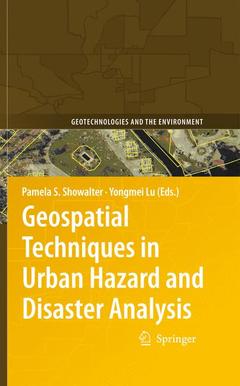Geospatial Techniques in Urban Hazard and Disaster Analysis, 2010 Geotechnologies and the Environment Series, Vol. 2
Langue : Anglais
Coordonnateurs : Showalter Pamela S., Lu Yongmei

This book is the second in a series that examines how geographic information te- nologies (GIT) are being implemented to improve our understanding of a variety of hazard and disaster situations. The main types of technologies covered under the umbrella of GIT, as used in this volume, are geographic information systems, remote sensing (not including ground-penetrating or underwater systems), and global po- tioning systems. Our focus is on urban areas, broadly de ned in order to encompass rapidly growing and densely populated areas that may not be considered ?urban? in the conventional sense. The material presented here is also unabashedly applied ? our goal is to provide GIT tools to those seeking more ef cient ways to respond to, recover from, mitigate, prevent, and/or model hazard and disaster events in urban settings. Therefore, this book was created not only with our colleagues in the academic world in mind, but also for hazards professionals and practitioners. We also believe graduate students will nd the material presented here of interest, as may upper division undergraduate students.
Sea Level Rise and Flood Analysis.- Modeling Sea-Level Rise and Surge in Low-Lying Urban Areas Using Spatial Data, Geographic Information Systems, and Animation Methods.- Urban Expansion and Sea-Level Rise Related Flood Vulnerability for Mumbai (Bombay), India Using Remotely Sensed Data.- A GIS for Flood Risk Management in Flanders.- Using Geographic Information Science to Estimate Vulnerable Urban Populations for Flood Hazard and Risk Assessment in New York City.- Geo-Information Technology for Infrastructural Flood Risk Analysis in Unplanned Settlements: A Case Study of Informal Settlement Flood Risk in the Nyabugogo Flood Plain, Kigali City, Rwanda.- Metropolitan Case Studies.- A Respiratory Riskscape for Texas Cities: A Spatial Analysis of Air Pollution, Demographic Attributes and Deaths from 2000 Through 2004.- Spatial Distribution of Toxic Release Inventory Sites in Chicago Area: Is There Environmental Inequity?.- Risk and Exposure to Extreme Heat in Microclimates of Phoenix, AZ.- Wildfire Risk Analysis at the Wildland Urban Interface in Travis County, Texas.- Early Warning of Food Security Crises in Urban Areas: The Case of Harare, Zimbabwe, 2007.- Earthquakes, Tsunamis, and International Applications.- Spatial Information Technologies for Disaster Management in China.- A Cybercartographic Tool for Supporting Disaster Prevention Planning Processes and Emergency Management in Mexico City.- Integration of Tsunami Analysis Tools into a GIS Workspace – Research, Modeling, and Hazard Mitigation efforts Within NOAA’s Center for Tsunami Research.- Utilizing New Technologies in Managing Hazards and Disasters.- Hurricane Response/Recovery.- Remote Sensing and GIS Data/Information in the Emergency Response/Recovery Phase.- Investigating Recovery Patterns in PostDisaster Urban Settings: Utilizing Geospatial Technology to Understand Post-Hurricane Katrina Recovery in New Orleans, Louisiana.- Space and Time Changes in Neighborhood Recovery After a Disaster Using a Spatial Video Acquisition System.- Evacuation Studies.- Pre-evacuation Trip Behavior.- Micro-Level Emergency Response: 3D Geometric Network and an Agent-Based Model.- A Planning Support System for Terror-Resistant Urban Communities.
Presents recent research on geographic information technologies (GIT) The main types of technologies discussed in this volume are geographic information systems, remote sensing and global positioning systems The goal is to provide GIT tools for more efficient ways to respond to, mitigate and prevent hazard and disaster events in urban settings
Date de parution : 03-2012
Ouvrage de 452 p.
15.5x23.5 cm
Date de parution : 11-2009
Ouvrage de 452 p.
15.5x23.5 cm
Thèmes de Geospatial Techniques in Urban Hazard and Disaster Analysis :
© 2024 LAVOISIER S.A.S.
